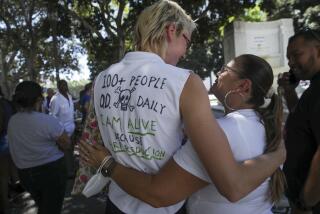Cancer Deaths Decline for 1st Time Since 1930
- Share via
For the first time since the government began keeping national death statistics in 1930, the number of cancer deaths in the United States has fallen as improvements in diagnosis, therapy and prevention have finally overtaken increases caused by aging and population growth.
The number of deaths declined by only a sliver -- 369 out of about 557,000 between 2002 and 2003, the latest years for which data are available.
But the American Cancer Society, which conducted the analysis, believes the downward trend is solid, and it is projecting a substantially larger decrease this year.
The results “mark a remarkable turn in our decades-long fight to eliminate cancer as a major health threat,” said American Cancer Society Chief Executive John R. Seffrin. “For the first time, the advances we have made in prevention, early detection and treatment are outpacing even the population factors that ... obscured that success.”
The number of cancer deaths in women increased by 409 in 2003, but that growth was offset by a decline of 778 in men, according to data from the National Center for Health Statistics in Hyattsville, Md.
“That may seem like a small number, but it represents an important milestone,” said Dr. Michael Thun, scientific director of the American Cancer Society.
The cancer society projects that deaths in 2006 will total about 565,000, down from an estimated 570,280 in 2005.
A continued decline could have substantial economic benefits. In 2005, direct medical costs of cancer care totaled $74 billion, while lost productivity and other effects added an additional $136 billion, the National Institutes of Health reported.
The decline is “not surprising, but it is very gratifying,” said Dr. Michael A. Friedman, president of City of Hope National Medical Center in Duarte. “It has taken quite a long time for us to reach this point.”
The disease causes 1 in every 4 deaths in the country, making it second only to heart disease. But the rate of cancer deaths -- not the number of deaths -- has been declining steadily by about 1% per year since 1991 as individual survival has improved.
When the government began keeping records in 1930, cancer accounted for 114,186 deaths and the U.S. population was 123 million compared with about 290 million today. .
A cancer diagnosis was nearly equivalent to a death sentence, the only treatments being rudimentary surgery and blasts of radiation, which was first used at the turn of the 20th century.
The first chemotherapy drugs were developed from poisons used in chemical warfare during World War II, but did not see much use for a decade more. The first recorded cure of a metastatic cancer with drugs occurred in 1956, when methotrexate was used to treat choriocarcinoma, a rare tumor of the uterus.
The first major step toward prevention was the surgeon general’s report on smoking in 1964, which delineated the hazards of tobacco, but it took two decades for that message to have what was considered a profound effect on smoking rates.
By the 1970s, half of those diagnosed with cancer survived for five years. For those diagnosed during the last half of the 1990s, the rate had grown to 65%.
Today, the National Cancer Institute estimates that there are 10.1 million living Americans who have had cancer. Men have about a 50% risk of developing cancer in their lifetimes, whereas women have a risk of about 1 in 3.
The biggest contributor to the decline in cancer deaths is the reduction in tobacco use over the last 30 years, Thun said. Tobacco use accounts for 30% of all cancer deaths, including lung cancer and 14 other types. Lung cancer is the most deadly in men and women and will account for about 162,460 deaths this year.
The incidence of lung cancer in men has fallen by about 24% since 1985. Among women, who in general did not begin smoking heavily until decades after men did, the incidence has leveled off since 1998 after a long period of growth.
Decreases in death rates of breast, prostate and colorectal cancers are also important contributors to the overall decline.
Breast cancer deaths have dropped about 2.3% per year since 1990 to an estimated 40,970 deaths in women this year and 460 in men. The declines are attributed, in equal measure, to improvements in treatment and early diagnosis, which allows tumors to be detected while they are easier to cure.
The incidence of prostate cancer has been rising and falling over the last decade as a result of changes in testing, but prostate cancer deaths have been declining steadily, to an estimated 20,360 this year. The death rates have been falling in whites and blacks, but African American men are still twice as likely to die from the disease.
Colorectal cancer deaths have been declining slowly, to an estimated 55,170 this year, as screening has increased -- although about 50% of those for whom screening is recommended are not receiving it. Screening allows the identification of benign polyps, which can be removed before they turn cancerous.
Treatments for colorectal cancer have also been improving, and the incidence is falling, “but we don’t know why for sure,” Thun said.
Friedman, of the City of Hope, said: “In general, people are eating more healthy food and going in for checkups more often.”






